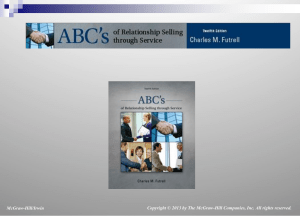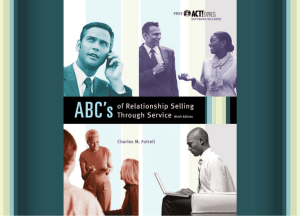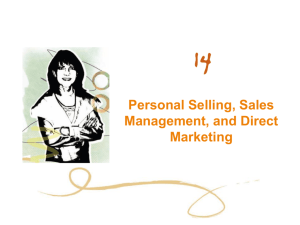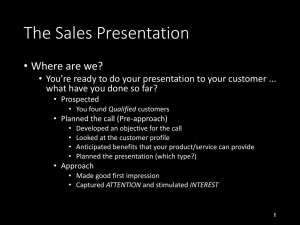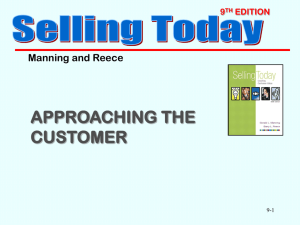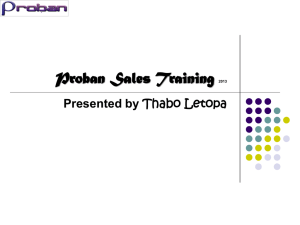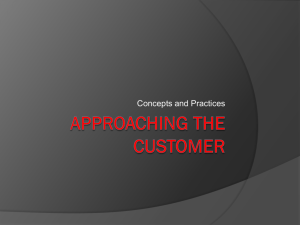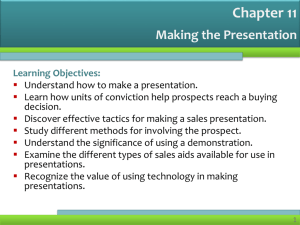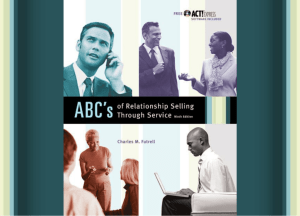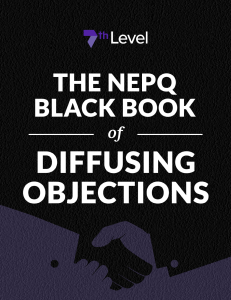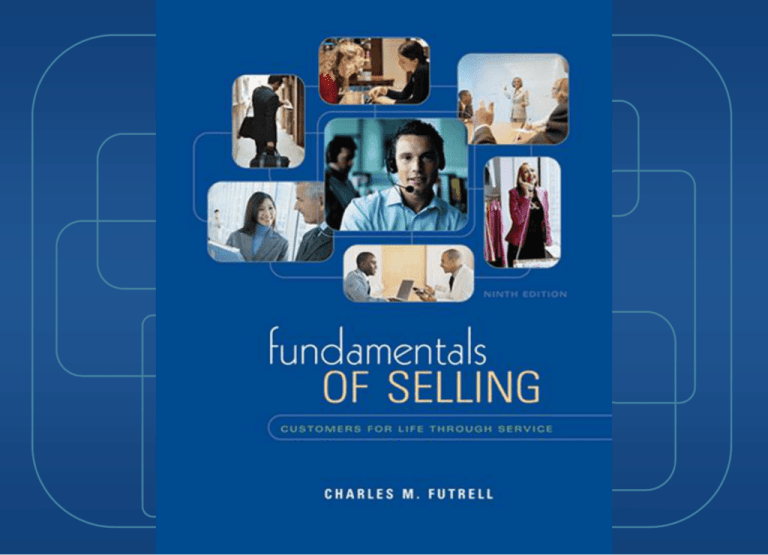
10-1
Chapter 9 - The Structure of Sales Presentations
10-2
Chapter 9 - The Parallel Dimensions of Selling*
Discussion Sequence
Discuss Product
Prospecting
Show Feature
Explain Advantage
Lead into Benefit
Let Customer Talk
Preapproach
Discuss Product
Present Marketing Plan
Explain Business Proposition
Suggest Purchase
Buyer’s Mental Steps
Money
Authority
Desire
Approach
Attention
Interest
Present Marketing Plan
Presentation
Selling Process
Presentation
Availability, Delivery,
Guarantee, Merchandising,
Installation, Maintenance,
Promotion, Training, Warranty
Desire
Trial Close
Determine Objections
Explain Business Prop
List Price, Shipping Cost,
Discounts, Financing, ROI,
Value Analysis
Meet Objections
Conviction
Trial Close
Suggest Purchase
Close
Product, Quantity, Features,
Delivery, Installation, Price
Action
(Purchase)
Follow-up & Service
10-3
Begin Your Presentation
Strategy
McGraw-Hill/Irwin
Chapter
10
Copyright © 2006 by The McGraw-Hill Companies, Inc. All rights reserved.
Main Topics
The Tree of Business Life: The Beginning
What is the Approach?
The Right to Approach
The Approach—Opening the Sales Presentation
Technology in the Approach
Chapter
10
10-5
Main Topics
Is the Approach Important? Using Questions Results
in Sales Success
Is the Prospect Still Not Listening?
Be Flexible in Your Approach
Chapter
10
10-6
For the Salesperson What Is the
Approach?
The time from when the salesperson first
sees the buyer to the beginning of the
discussion of the product.
AKA – introductions, chit chit and building
interest and desire
10-7
The Approach
Could last seconds or minutes and involves:
Meeting
Greeting
Rapport Building
One of the approach communication techniques
discussed in this chapter
10-8
Caution Salespeople
Take the approach seriously
Some feel this is the most important step in
helping someone
If unsuccessful, you may never have
opportunity to move into the presentation
If you can not tell your story how will you
make the sale?
The approach is extremely important
10-9
The Approach Step of the Sales
Presentation
Is over when you begin discussing the
product itself
10-10
Let’s Summarize! The Salesperson:
Meets
Greets
Rapport Builds
Goes through the approach
Discusses the product
Discusses the marketing plan
Discusses the business proposition
Closes – asks for the order
10-11
Approach Categories
Opening with a statement
Opening with a demonstration
Opening with a question or questions
10-12
Exhibit 10-5: The Approach Techniques for
Each of the Four Sales Presentation Methods
10-13
Objectives of Both Statement and
Demonstration Approach Techniques
Attention
Interest
Transition
10-14
The Approach Leads Quickly Into the Sales
Presentation
10-15
Exhibit 10-6: Approach Techniques for
Opening the Presentation
10-16
Opening With Statements
Introductory approach
The most common and least powerful
“Hello my name is Bob Smith and I’m with ABC Corp”
Complimentary approach
“Mr. Jones, I am so impressed with your staff and the
welcome they gave me at the front desk”
Referral approach
The use of another person’s name
“Mr. Jones, my name is Bob Smith with ABC and Peter
Cottontail suggested that I contact you concerning our
product line.”
Premium approach
Works because everybody like to receive something for free;
use of free samples and novelty items
10-17
Demonstration Openings
Product approach
Salesperson places product on counter and waits
for a reaction
Ex – New product shape, color or size (pepsi)
Showmanship approach
Doing something to catch the prospect’s attention
or interest
Super glue example
10-18
Opening With Questions
Most common openers
Customer benefit approach
...reduce your costs by 50%
Curiosity approach
…do you know why students can save
tuition?
Opinion approach
What is you honest opinion about our
product…
Shock approach
Did you know that 20% of all business’
are victims of shoplifting?
10-19
Four Question Categories
Asking questions is an excellent technique for
A.
B.
C.
D.
Obtaining information from the prospect
Developing two-way communication
Increasing prospect participation
Catagories:
1.
2.
3.
Direct – close-ended
Nondirective – open-ended (Who, What, When, Where, How or Why
Rephrasing – repeating the clients statement in a question format
4.
Redirect questions – used to redirect the prospect to selling points
that both parties agree on
10-20
The Direct Question
Can be answered with a few words such as:
“Mr. Jones, is reducing manufacturing costs
important to you?”
“What kind?”
“How many?”
Never phrase as a direct negative or a
question that can cut you off
Example: “May I help you?”
10-21
The Direct Question Limitations
Does not really tell you much
There is little feedback information
10-22
The Nondirective (Or Open-Ended)
Question
Begins with who, what, where, when, how,
or why
“Who will use this product?”
“What features are you looking for in a product
like this?”
Its purpose is to obtain unknown or
additional information
10-23
The Rephrasing Question
Is useful if you are unclear and need to clarify
the meaning of something said
“Are you saying that price is the most important
thing you are interested in?”
“Then what you are saying is, if I can improve the
delivery time, you would be interested in buying?”
10-24
The Redirect Question
Used to change the direction of the conversation –
often from a negative to a positive
Imagine you walk into a prospect’s office, introduce
yourself, and get this response:
“I’m sorry, but there is no use in talking. We are satisfied with
our present suppliers. Thanks for coming by.”
A redirect question would be:
“Wouldn’t you agree that you continually need to find new
ways to increase your company’s sales?”
10-25
Three Rules for Using Questions
1. Use only questions that you can anticipate
the answer to or that will not lead you into a
situation from which you cannot escape
2. Pause or wait after submitting a question
3. Listen
10-26

